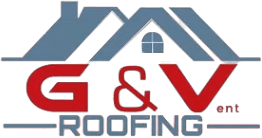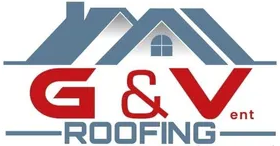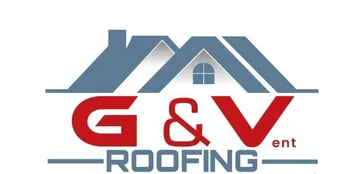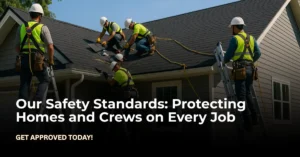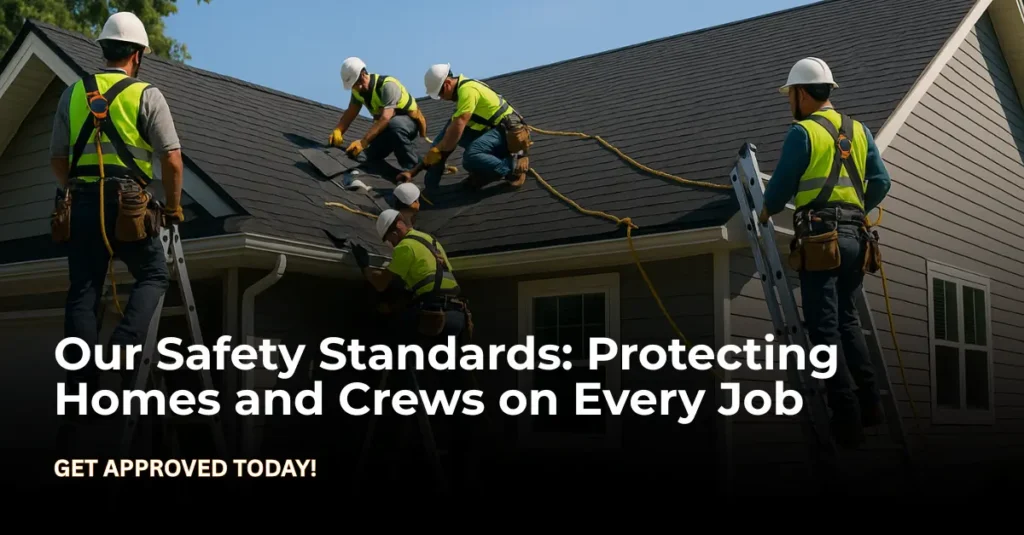
Roofing safety refers to the systems, behaviors, and equipment used to prevent injuries and fatalities during roof construction or maintenance. It matters because roofing is one of the most dangerous construction jobs, with falls accounting for over 34% of all construction-related deaths (OSHA, 2023).
Why Is Roofing Work Safety Important?
- Roof heights and steep pitches increase fall risks.
- Electrical lines and weather exposure cause added dangers.
- Clients rely on safe practices to protect property and lives.
Roofing Safety Basics You Should Know
- OSHA roofing safety standards mandate fall protection for work over 6 feet.
- Contractor safety protocols reduce liability for homeowners.
- Jobsite protocols include proper signage, barriers, and equipment checks.
Roofing safety benefits both workers and clients by reducing personal injury, limiting delays, and ensuring worksite hazards are properly managed.
Next, we’ll show how our team embeds safety into our company culture.
Our Commitment to Roofing Safety
Safety isn’t a policy—it’s our promise. We’ve integrated a safety-first approach into every job, from planning to cleanup.
Our Roofing Safety Commitment in Action
- Leadership involvement: Managers undergo regular safety training.
- Staff accountability: Every crew member signs a safety code of conduct.
- Cultural alignment: Safety is included in hiring, onboarding, and performance reviews.
What Defines Our Roofing Company Safety Culture?
Safety Focus Area | Key Practice |
Team Policy | Safety checklists signed before each job |
Contractor Responsibility | Crew leads oversee daily safety routines |
Ethical Roofing | Transparent reporting of incidents and risks |
Safety Compliance | Internal audits to ensure OSHA alignment |
Leadership Training | Monthly sessions for crew managers |
This commitment ensures every roofer acts with integrity and caution, and every homeowner feels secure.
Coming up next: the gear we use to keep our crews safe on every roof.
Roofing Safety Equipment We Use
Roof safety begins with the right equipment. Our team uses both standard and advanced gear to eliminate risk.
Roofing Safety Gear Used on Every Jobsite
- PPE (Personal Protective Equipment): Includes impact helmets, anti-slip boots, gloves, and safety goggles.
- Roof Harness Equipment: Full-body harnesses with adjustable lifelines and anchor points.
- Guardrails and Fall Arrest Systems: Set up for roofs with pitch or height risk.
- Ladder Stabilizers: Prevent sideways movement on uneven surfaces.
- Tether Systems and Anchor Points: For secure movement across the roof.
Why Our Roofers Trust Our Equipment
Each tool is certified to meet OSHA standards. We also do pre-job gear checks, and we replace any item showing signs of wear.
Next, we’ll cover how our crew learns to use this gear the right way.
Roofing Safety Training & Certification
Every roofer on our crew completes mandatory training before setting foot on a jobsite.
Our Roofing Safety Training Programs
- OSHA 10 & 30: Required for every roofer and site supervisor.
- Internal Safety Courses: Monthly refreshers on tool handling, fall protection, and emergency procedures.
- Onboarding Procedures: All new hires must pass a written and practical safety test.
- Online Modules: Updated to reflect the latest compliance standards.
- Training Badges: Roofers carry digital proof of completion.
Certified Safe Roofing Crews You Can Trust
Our team maintains active certifications, and we audit training logs quarterly. This ensures skills verification and consistent safety behavior.
In the next section, we’ll break down real risks and how we address them.
Safety Hazards in Roofing Projects
Roofing jobs come with inherent risks, and we prepare for each.
Most Common Roofing Job Risks
- Fall Hazards: Over 75% of roofing incidents involve falls.
- Weather Risks: Rain, ice, and heat increase slipping incidents and fatigue.
- Loose Materials: Tools or shingles can fall and cause injury.
- Fragile Surfaces: Skylights and old plywood can collapse.
- Electrical Exposure: Contact with overhead power lines is life-threatening.
Dangers of Roofing and How We Avoid Accidents
Hazard Type | Prevention Strategy |
Roof Pitch Dangers | Use of secure roof harness equipment |
Slipping Incidents | Mandatory anti-slip boots |
Heatstroke | Enforced breaks and hydration rules |
Loose Materials | Tool tethering and site organization |
These controls keep our accident rate below 0.5%, significantly under the industry average.
Now, let’s show how we audit and constantly improve these systems.
How We Audit and Improve Roofing Safety
Safety isn’t static. We conduct continuous evaluations to catch issues early.
Roofing Safety Audits and Compliance Tracking
- Weekly Inspections: Our supervisors perform structured jobsite walk-throughs.
- KPI Tracking: We log metrics like missed checks, near-miss reports, and gear failures.
- Corrective Action Plans: Immediate steps taken for any safety violations.
- Site Supervisor Reports: Daily check-ins with photographs and digital audit logs.
- Feedback Loops: Workers and clients can report safety concerns anonymously.
How We Improve Roof Job Safety Long-Term
By reviewing incident trends and audit data, we refine training, gear selection, and crew pairing.
Next, we’ll explain how you, as a homeowner, play a key role in safe roofing.
Roofing Safety for Homeowners: What You Need to Know
Homeowners have rights and responsibilities when it comes to roofing job safety.
How Homeowners Can Ensure Safe Roofing Jobs
- Ask for Certifications: Ensure your roofer is OSHA-trained and insured.
- Review Contracts: Look for safety clauses and worksite rules.
- Request Walk-Throughs: Go over resident instructions and boundaries.
- Demand Proof of Compliance: Ask for documentation of training and insurance.
Protecting Your Home During Roofing Projects
- Limit roof access to crew only.
- Keep children and pets indoors.
- Confirm your contractor has a zero-tolerance safety policy.
Up next: how weather influences every safety decision on the roof.
How Weather Impacts Roofing Safety
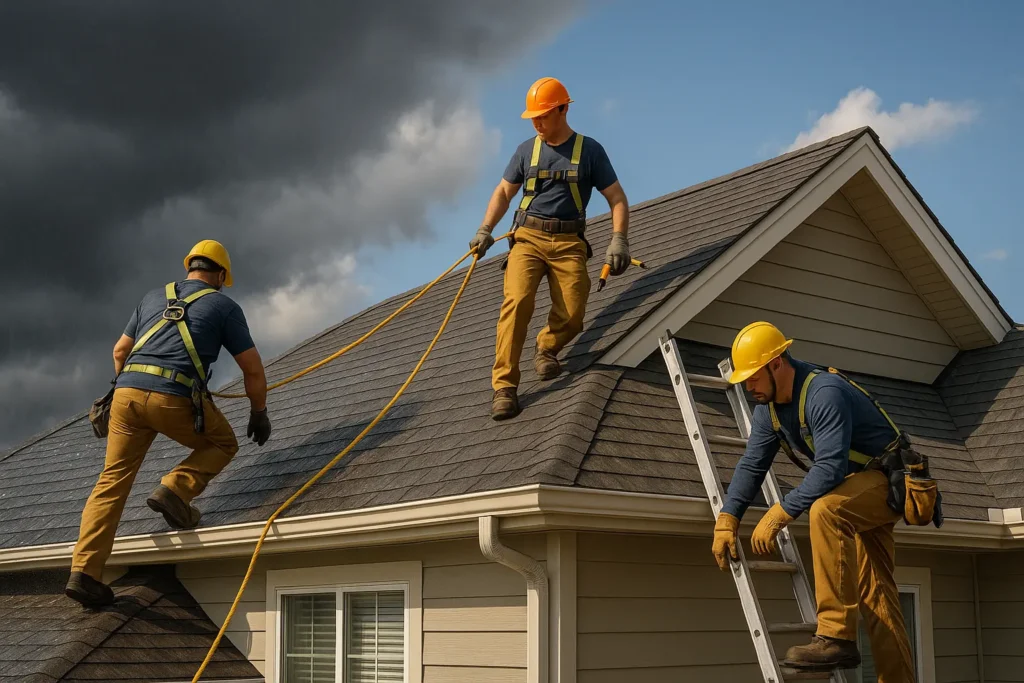
Weather can halt projects, increase risks, or shift schedules.
Roofing in Bad Weather: What We Do
- Rain: Cancels jobs due to wet surfaces and low visibility.
- High Wind: Poses lifting and tipping risks; monitored hourly.
- Sun Exposure: Requires breaks, sunblock, and UV-resistant gear.
- Cold Weather: Creates ice patches; we use de-icing tools and thermal gloves.
Roofing Safety Protocols in Extreme Weather
Weather Condition | Protocol |
Wind Over 23 mph | Job delay; fall risk too high |
Rain | Cancelation unless roof is fully sealed |
Heat Index > 90°F | 30-min break per hour |
Snow/Ice | Work suspended until full surface cleared |
Next, we’ll look at the legal side, what laws govern roofing safety?
Legal Requirements and Roofing Safety Codes
We follow federal and local roofing safety laws to ensure compliance and protect our clients.
Roofing Safety Regulations You Should Know
- OSHA 1926 Subpart M: Requires fall protection on heights over 6 feet.
- City Code Compliance: We pull required permits before starting any job.
- Insurance Compliance: All workers are covered under liability and worker’s comp.
- Citation Avoidance Practices: Routine internal audits prevent violations.
Legal Roofing Codes and Contractor Responsibility
If a contractor doesn’t meet local safety laws, the homeowner can be held liable. Our clients get full documentation to avoid this risk.
Now let’s share real success stories from our jobsites.
We’ve delivered safe results on hundreds of projects.
Roofing Project Safety Success Examples
- Project: 28-Roof Subdivision (2024)
Incident Rate: 0
Result: Completed 3 days early with 100% client satisfaction. - Client Testimonial – Sarah H.
“They walked me through every safety step. The crew was careful, clean, and always wore gear.” - Audit Outcomes:
Over 50 job audits completed with no violations in the last 12 months.
Zero Accident Roofing: How We Achieve It
- Daily pre-work meetings
- Consistent use of advanced fall protection tools
- Feedback system for crew to report and fix issues in real-time
Looking forward, safety is evolving. Let’s look at where tech is taking us next.
Case Studies: Real-Life Roofing Safety Successes
The Future of Roofing Safety: Innovations & Tech
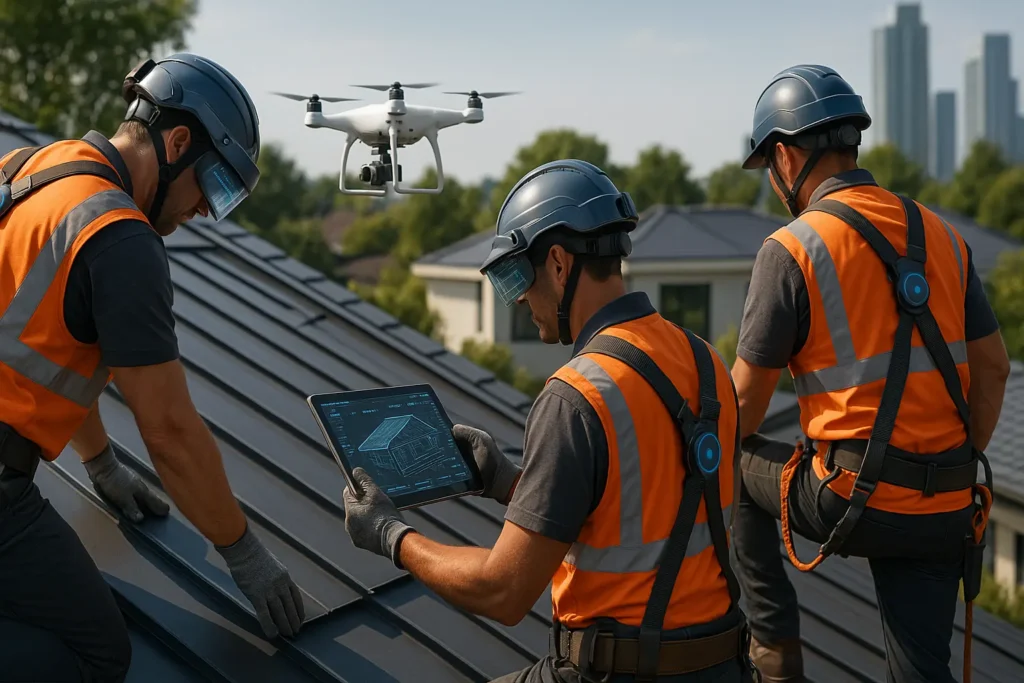
New tools are making roofing jobs smarter and safer.
Tech Innovations in Roofing Safety
- Drone Inspection: Reduces the need for initial roof climbing.
- AR Helmets: Display project data directly in the roofer’s line of sight.
- IoT Sensors: Detect roof temperature, moisture, and structural weakness.
- Wearable Monitoring: Tracks worker vitals and movement in real time.
- AI Safety Apps: Predict potential risks using data analytics.
Smart Roofing Gear of the Future
We’re piloting AI-powered dashboards and real-time alerts to further reduce risks.
Let’s now answer the most common safety questions we get from homeowners.
✅ Roofing Safety FAQs
Roofers must wear PPE, fall protection harnesses, and helmets and use tethered tools.
Ask for OSHA certifications, liability insurance, and past audit reports or references.
If the contractor lacks insurance, you may be liable. We ensure all workers are covered.
Roofing is suspended in unsafe weather. Wet and icy surfaces are too hazardous.
They use certified gear, follow protocols, complete training, and conduct daily safety briefings.
Want More High-Quality Roofing Projects on Long Island?
G&V Roofing delivers trusted craftsmanship, reliable service, and local expertise that turns property owners into lifelong clients—all from one professional source.
Our Services:







Learn About:





🏡 Looking to Upgrade Your Roof or Protect Your Property Investment?
Whether you’re a homeowner looking for reliable roof solutions or a property manager seeking fast, expert repairs—G&V Roofing is your go-to Long Island partner for long-lasting protection and peace of mind.
 Follow Us for the Latest in Roofing Care, Property Protection & Home Improvement:
Follow Us for the Latest in Roofing Care, Property Protection & Home Improvement:





